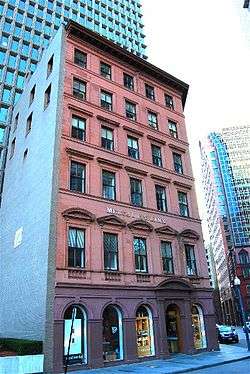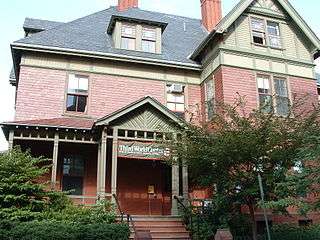Alpheus C. Morse





Alpheus Carey Morse (June 3, 1818 - November 25, 1893)[1] was an American architect, with offices in Providence, Rhode Island.
Morse was born in Boston in 1818. His father was Hazen Morse, a noted engraver. As a young man, Morse studied under Alexander Parris, before going off to study in Europe. He first appears in the 1847-48 Boston directory, as an artist with rooms on Tremont Row. His first architectural commission was a church in Haverhill, the town that his family was from. In 1852, Boston architect George Snell employed Morse to design the interiors of the Boston Music Hall.[1]
Morse arrived in Providence in 1853. Initially, he was there to furnish designs for the house of a friend, Thomas A. Hoppin. This house, completed the same year, still stands at 383 Benefit Street. In 1855 he formed a partnership with Clifton A. Hall in Morse & Hall, a firm remembered solely for the Merchants Bank Building. This firm only lasted for the year. Upon the death of Thomas A. Tefft, Morse became the city's most sought-after architect. Through the 1870s he was known for designing houses and other buildings in a chaste Italian Renaissance style. The public taste changed, however, and in the last years of his practice Morse ably worked in the High Victorian Gothic, Romanesque Revival, and Queen Anne styles.
In 1857 he was a founding member of the American Institute of Architects.[2] He designed many prominent buildings in Providence, including the old Rhode Island Hospital and Sayles Hall on the campus of Brown University.
Works
- First Parish Unitarian Church, 130 Main St., Haverhill, MA (1847–48) - Most recently St. Gregory Church.[3]
- Boston Music Hall (Interior), 1 Hamilton Pl., Boston, MA (1852) - Remodeled.
- Thomas F. Hoppin House, 383 Benefit St., Providence, RI (1853)[4]
Morse & Hall, 1855:
- Merchants Bank Building, 20 Westminster St., Providence, RI (1855–57) - With Clifton A. Hall.[4]
Private practice, 1855-1893:
- William Binney House, 71 Prospect St., Providence, RI (1859)[4]
- Henry A. Rhodes House, 101 Benefit St., Providence, RI (1860–62)[5]
- Amos N. Beckwith House, 2 Stimson Ave., Providence, RI (1861–62)[4]
- Smith Owen House, 79 Prospect St., Providence, RI (1861)[4]
- Rogers Hall, Brown University, Providence, RI (1862)[4]
- Rectory of St. John's Episcopal Church, 144 Benefit St., Providence, RI (1863)[4]
- Mrs. Mary A. Gorham House, 34 Benefit St., Providence, RI (1863–65)[4]
- Rufus Waterman House, 188 Benefit St., Providence, RI (1863)[4]
- Rhode Island Hospital (Exterior), 593 Eddy St., Providence, RI (1864) - Floor plan by Samuel Sloan[4]
- James Humphreys House, 147 Benefit St., Providence, RI (1864–66)[4]
- William G. Angell House, 30 Benefit St., Providence, RI (1864–67)[4]
- William Slater House, 54 College St., Providence, RI (1867) - An extensive remodeling of a house built in 1838.[4]
- Fernald Hall, University of Maine, Orono, ME (1868–70)[6]
- Atlantic Building, 49 Westminster St., Providence, RI (1869–70) - Demolished[7]
- Brown Mausoleum, North Burial Ground, Providence, RI (1869)[8]
- Breck Building, 35 N. Main St., Providence, RI (1870) - Demolished.
- Charles H. Sprague House, 17 Arch St., Providence, RI (1874)[4]
- Lucian Sharpe Duplex, 130-132 Angell St., Providence, RI (1874)[4]
- Wickenden Street Fire Station, 202-212 Wickenden St., Providence, RI (1876) - Demolished.[7]
- William F. Sayles House, 103 Prospect St., Providence, RI (1878)[4]
- Sayles Hall, Brown University, Providence, RI (1879–81)[4]
- Henry T. Beckwith House, 68 Brown St., Providence, RI (1883)[4]
- Sullivan D. Ames House, 172 Cushing St., Providence, RI (1884–85)[7]
- Lucian Sharpe Carriage House, 135 Angell St., Providence, RI (1885)[4]
- Horatio Rogers House, 264 Bowen St., Providence, RI (1887)[4]
- Sundial, Mt. Vernon, Fairfax County, VA (1887) - Donated by the Rhode Island chapter of the Mt. Vernon Ladies' Association. It has been replaced with a more historically-accurate version.[9]
References
- 1 2 American Architect and Building News 9 Dec. 1893: 126-127.
- ↑ American Institute of Architects Quarterly Bulletin April 1907: 7-8.
- ↑ "First Parish Unitarian Church of Haverhill" mhc-macris.net. Massachusetts Historical Commission, n. d. Web.
- 1 2 3 4 5 6 7 8 9 10 11 12 13 14 15 16 17 18 19 20 Woodward, William McKenzie. Providence: A Citywide Survey of Historic Resources. Providence: Rhode Island Historical Preservation Commission, 1986.
- ↑ Jordy, William H., Buildings of Rhode Island. New York: Oxford University Press, 2004.
- ↑ "Celebrating 150 Years: Fernald Hall". https://umaine.edu. n.d. Web.
- 1 2 3 Industries and Wealth of the Principal Points in Rhode Island. New York: A. F. Parsons Publishing Co., 1892.
- ↑ Jordy, William H. and Christopher P. Monkhouse. Buildings on Paper: Rhode Island Architectural Drawings, 1825-1945. Providence: Brown University, 1982.
- ↑ Report of the Mount Vernon Ladies' Association of the Union, 1889. Baltimore: Friedenwald Co., 1896.